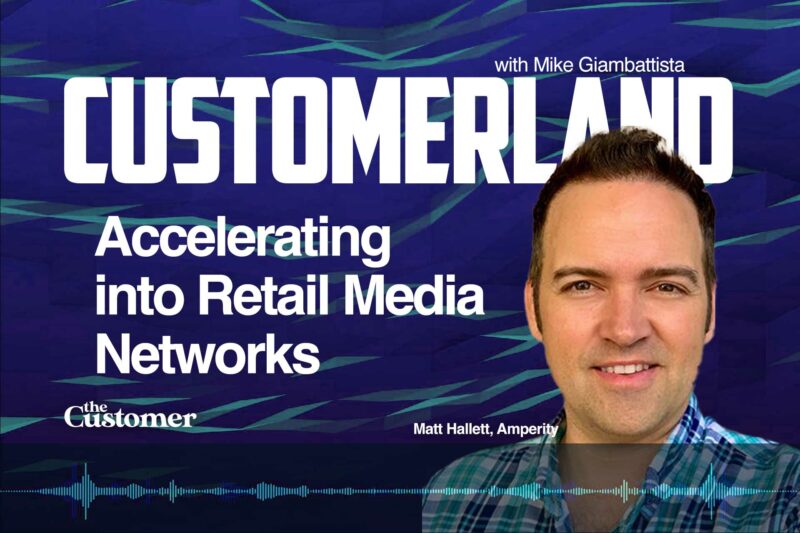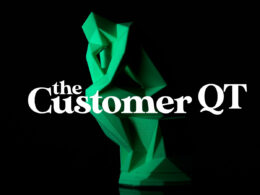Amperity is, at its core, a CDP. But as I suspected, and as Matt Hallett, their head of product solutions revealed, Amperity has something of a secret sauce that has put it right at the center of the explosion in retail media networks.
Beyond RMN’s though, this conversation is one of the best primers you’ll find on the differences between CDP types and what makes one better for some applications than others.
 Also a big nod to our sponsor for this episode, TheCRMC.
Also a big nod to our sponsor for this episode, TheCRMC.
Full transcript below
Mike Giambattista:
I’d like to welcome Matt Hallett to the conversation. Matt is head of product solutions at Im Pardy, which is a CDP that if you haven’t heard of, I’m not sure where you’ve been hiding.
Matt Hallett:
That’s so true, <laugh>.
Mike Giambattista:
So Matt, thanks for joining me. Really appreciate it. One, I’m think, but not positive that I pronounced your last name correctly,
Matt Hallett:
<Laugh>. You sure did.
Mike Giambattista:
And I’m just wondering, give us, just, just for context kind of a brief of what Amperity does because it’s, it’s a CDP that operates Yeah. A little bit more uniquely, I’d say in description than, than a lot of others.
Matt Hallett:
Well, yeah. The, you’ve already cut to the punchline there. Absolutely. So, yeah, Amperity started in 2016. It is a customer data platform in the vein of customer data infrastructure. Those companies that recognize that they need to build upon a first party foundation of knowing who the customer is. That’s not just what happened yesterday, but it’s what happened since inception. So they can drive better customer experiences, better analytics, better reporting and also now what’s happened in ecosystem, there’s a lot of better new customer acquisition as a result of what they know about who they know. And so, yeah, 2016 software is a service platform and extension of it and marketing infrastructure to help people to build upon said foundation to drive those experiences. As we’ve said, about 400 of people about four or so brands across the globe multi continent now.
Some of the largest brands, mostly a lot of blue chip Fortune 500 companies use us heavy footprint and retail unifying online sales transactions, offline sales transactions to help kind of drive that solid foundation, overlaying with second party data, third party data were appropriate to help them to augment and extend their knowledge. Yeah. And so really excited about that. And yeah big strong footprint in retail. But now some really great wins in telco traveling, hospitality finser. It’s essentially the, you know, no one there isn’t enough company out there that doesn’t have a I need to know more about my customer problem.
Mike Giambattista:
Right, right. I’m super intrigued by the fact that you’re a 2016 company yet you’re servicing, and I was on your site earlier looking at some the names. Yeah. That’s no small task for, for anybody, much less a company that’s only been around for six years at this point, or seven or whatever it is. That’s, yeah, that’s some pretty serious brands and some pretty serious accomplishments there. Accomplishments. Well,
Matt Hallett:
I’m really glad you noticed that. And that’s because the, the founding team who the founding team had cut their chops on this space or prior 10 years prior to that as well too. Primarily life sciences and pharmaceutical space, a little bit of medical device. But they had just constantly been hitting that same problem over and over and over. That 85% of companies want to have a unified customer profile that they can trust. And yet only 14% had actually really achieved it. And that, you know, that that constant slog of working through CRM and mdm and enterprise data warehouses and all these initiatives, no one had really achieved that. So they really kind of got a bit of a let’s say a fast pass to the front of the line in 20 2016 by building upon that legacy of knowledge.
Mike Giambattista:
So, I mean, again, I kind of look at this, at what you’re doing from the sidelines. It’s, that’s, that’s my role here, sidelines commentator. But if, if you look at the explosion in cdp, you know, 2016, 17, maybe 18, they just seem to proliferate. You know, they, they were everywhere. And it was, it was and remains a critical component of anybody’s stack. Yeah. But there was a maturity level that you guys seem to have achieved ahead of everybody else’s curve. And, and that’s basically all what I’m attributing your great client roster to
Matt Hallett:
Hundred percent. I mean, the, the idea of mastering first your customer data is as old as time, right? I mean, database marketing service providers, marketing service providers, CRMs , there’s no shortage of three litter acronyms acronym.
Totally. but yeah, I think CDP and the way that they approached it was truly, look, look, you know, any brand has 91 marketing solutions today to engage customers. And that’s just known customers. That’s not, not even the unknown customers, right? The, the dark black magic of, of ad tech phase. And that’s just in marketing. They, they recognize that, look, we, if we’re gonna truly build a, a foundation there, it has to be in service of marketing service, sales has to be a foundation that it and analysts can trust. And so, I mean, they really lean into that hard problem. And that’s why there’s eight patents, 45 maur Merton models, essentially everything that is about using the best and scalable cloud technology, ai to help customers to understand who their customers are, as if a human was looking at it to the scale.
That’s a necessity to be able to batch process. I think we have six and a half billion brand customer relationships under management today, which represents, you know, trillions upon trillions of data sets of data to be normalized and due and consolidated to, to provide that foundation. But to do that on a, at a, on a, on a scalable process was impossible for any single organization. So we wanted to build that platform for people to go able to leverage that as a service, an extension of their AWS stack or their Azure stack accordingly.
Mike Giambattista:
Well maybe in a future conversation, I’d love to have a real discussion around some of the learnings that you’ve gleaned from that, because you, you get to observe a live right that’s way bigger than most other people have had access to. So and we do, we do primary research for a handful of people. We do secondary research for a handful of people, and most of it centers around consumer insights from massive data sets, so mm-hmm. <Affirmative> mm-hmm. <Affirmative>, next time over a big glass of ice tea you or something. We’ll discuss all that stuff. Love it.
Matt Hallett:
Yeah. Lots of clips. I think our favorite is, you know, 80% of your business comes from 20% of your customer base but the 20% of your customers have the dirtiest data, and we can prove it. All. Right? And so, you know, based upon all that mass amount of data and seeing the trends there, certainly it’s gotta be a very tall glass of ice tea.
Mike Giambattista:
Yeah. Right, right. <Laugh>. So one of the things, one of the several things that really caught my attention when we first started this conversation was am parody willingness to lead off with retail media networks. It’s, it’s I don’t have to tell you and the listening audience probably already knows this, but it is a massive, massive, almost historically unforeseen shift in spend toward out of traditional digital channels into retail media networks. That’s just, I think that the technology base that supports it probably isn’t even ready for that. I, I know that the companies that are behind some of these bigger shifts are, are scrambling to handle the, the tide that’s just gonna be flowing their way. But here’s Amperity you know, a leading C D P saying, Hey, let’s talk, let’s talk retail, let’s have that discussion, which is an interesting place to, to start a C D P discussion.
Matt Hallett:
Absolutely, absolutely. We sit at a unique spot where we have probably about 20 or 25 customers that have some version of a ma in, in a maturity curve of launching a retail media network, which it is certainly a kindergarten to collegiate continuum for anyone in the organization going through that. The internal battles, the legal battles, the, the whose money and whose pocket is this coming out of and, and, and et cetera. There’s a lot of, there’s companies at different stages. So we have this kind of front row seat to see that evolution in them across the continuum. And then the 300 plus brands that we, they have that don’t have the retail media network, and they’re not a media or publishing platform but they’re looking at those, they’re looking at those media those retail media network as the holy grail, as the ability to truly, yes, be able to get attribution as associated to your ad spend.
But you’ve gotta work through the tenuous at odd sometimes relationships between the brand and the wholesale retailer, right? So, yeah, we get, yeah, it’s, it’s fascinating. So to see that we get a front row seat to both sides of the equation, we already are platform. When you have for mastered, cleaned, unified first party data inside of our platform for our customers, they’re able to immediately activate and send that data to certainly the email and the SMS campaigns, all that. But we’re seeing a rise in people needing to take that to Facebook’s and talks and Google’s for the upper funnel activation, right? Story. Well guess where we want to have there. It’s just not just Facebook, Google, and TikTok as in destinations for your pay media, but for all of our customers. Also, the retail media networks that are also on the Amperity foundation. So it’s a great story and, and helping our customers that are in our ecosystem to get closer together across that brand marketing and performance marketing band together in the changing face of the pandemic, the recession, the ever threat of Amazon, and all the things associated to why retail media networks exist.
Mike Giambattista:
Well I, you know, I was at NRF for three days, it seemed like a week.
Matt Hallett:
Me too. Oh, man.
Mike Giambattista:
But it was wild. It was really a great show. So many companies debuting innovative approaches to some of the, you know, the problems that the industry’s faced for so long. Well, hey, look at that. There’s an interesting wrinkle on a solution here. A lot of people talking about retail media networks. I spoke with a handful, a couple of handfuls of companies that were developing that had developed kind of last mile technologies for delivering those ads from the ad networks. When you question them about, and I hope this doesn’t sound disparaging cause I don’t mean it that way, but when you, when asked about, okay, where does the data come from? Where does it go? They, I guess in their own way said, well, we need, we need a, a CDP that can handle this. And that’s the truth. Not all CDs are built equal. They’re not, not all CDPs. In fact, I would say that service marketing first really got built to handle media in any context,
Matt Hallett:
Mike, you get it.
Mike Giambattista:
You know, scalable way. So when we first had this, this initial conversation, okay, this could be really interesting because now I get a front row seat to watch how you guys interact with and how all these other last mile delivery technologies you know, now they have a, a source. I’m ha by the way, I’m happy to plug you guys in together. So
Matt Hallett:
That sounds great. That sounds great. No, I think, I think what we’ve seen, and I’ve been great to be part of a lot of these conversations, is that at some of our retail media networks, which I’ll keep them spec the names specifically out of this for all the reasons they said, look, you know, we were lucky that we’d chose, IM pardy for our identity for our identity management of bringing our customer profiles together. And we did that for it, we did that for analytics, and we did that for our marketing and engagement for unknown customers. We were lucky that we made that decision because retail media networks fell in our lap as far as a trend in the market, in eca, in the eco scape. And in Perry helped us to skip the crawl, walk, run stages or crawl walk to essentially get to the run stage.
Where a lot of retail media networks out there, you know, kind, it’s kind of easy to get started with retail media network, right? You, you, you license with a few of the name players out there, the crio, the citrus ads from IQs. You install a pixel here and there and boom, you’ve got ads up on your site. But what the question is, is like how are you gonna differentiate? How, how are you gonna get to quality? How are you gonna build transparency and responsiveness and also lower the margins that you’re, your overall needing to pay when you’ve just outsourced the entire thing to a solution that’s out there? So for, yeah, for the retail media networks that we have, they’re really excited about that foundation cuz they already had it and, and they’d already crossed that chasm overall. And our customers that were identity only and then, and came to a retail media network, it’s, it’s the same kind of paradigm that we’re seeing out there repeatedly, which is great cuz yeah, A C D P that is a kind of a marketing focused one, or a tag management event routing solution.
Those are not made for, those are not made for retail media networks. Right.
Mike Giambattista:
You’re gonna have to square peg something in a round hole that work if it’s not from scratch.
Matt Hallett:
AB especially our bread and butter is helping to kind of cross that chasm of online to offline. 90% of sales transactions still happen offline in stores. Thank God for our retailers, right? But attri, you gotta get to that attribution. So if you’re out there and you’re only able to correlate your, your spend that you’re selling to the add ecosystem to the 10% of the online purchasers, but you can’t get it to that offline, you’re, you’re missing a lot. And so that’s another great foundation that we, we bring to bear for, for, for our ecosystem there.
Sponsor Announcement
This isn’t so much a sponsor message as it is an encouragement each year for the past 20 years or so, the world’s best marketers have been gathering in Chicago for two and a half days of high level learning and networking. It’s called CRMC on my calendar. I’ve placed a hard hold on June 7th through the ninth so that I can be there and be a part of what’s about to happen in retail, in loyalty and in technology. You should be there too.
You can learn more and you can register in the link below this podcast, or you can go directly to the event website at thecrmc.com. That’s THE CRMC.com. I go to my fair share of events throughout the year. CRMC is my one can’t miss event of the year. I hope to see you there.
Mike Giambattista:
You know, I I’ve spoken to just really just a small handful of organizations that are building out their retail networks, retail media networks that I would say are approaching it with any degree of maturity and sophistication. And I don’t really have a sense of what the percentages are, but I would guess that there are a majority of companies that are looking into RMNs that are really just looking at as like, Hey, look, another, another profit center, another profit. Mm-Hmm. <affirmative> mm-hmm. <Affirmative>, here’s another channel for, for a message. But you know, at its highest utility and rmn can, you can derive so much customer data out of those things just because it’s a, it’s a unique series of channels that have never even existed before.
Matt Hallett:
Absolutely. Absolutely.
Mike Giambattista:
It’s gonna be really interesting to see, you know, how that maturation kind of goes. I mean, is, you know, they’re, as you’ve mentioned, there are some huge ones out there and they’re already doing it really well. But yeah,
Matt Hallett:
What, what I love are the ones that have now, and that you’re right about the maturity, the ones that stop calling their CPG product partners, supply partners, whatever word you want to call it, they start calling ’em clients. I, I love that evolution and, and because it’s essentially certainly another revenue source, certainly a great high margin business, onsite, offsite, all those things. But it’s also a way to treat your product partners, your, your, your c PPG suppliers as clients, and what a great way to kind of grow that relationship, treat it with the respect, keep them from going to d TC at the further they were during that pandemic. Right? Right. Keep them from going to the competitor who also has a retail media network, by the way. And, and including the, the lion in the room. They ultimately will talk about Amazon who is eager for any dollar but doesn’t have the 90% of offline sales transactions that they need to show return on ad spend efficiency or effectiveness or attribution. Our, our retailers do. And so anyways, yeah. So the, the closer they get to these relationships, the better they can make these relationships. I think it’s a great win-win win for that ecosystem and the supply chain. It’s a great win-win for the customer experience throughout all of it. And certainly should help our customers retailers specifically to remain not only just relevant, but to dominate in market.
Mike Giambattista:
Yeah. So we, we, we, I’m, I hope we do get a chance to talk about this ad nausea, cause there’s so much to talk about here, but let’s not do that in this call. Instead I want to just talk a little bit while we’re still here together about what is now a fairly tired topic, and that is <laugh> like
Matt Hallett:
Talking about,
Mike Giambattista:
I mean,
Matt Hallett:
Do those cookies have mold on ’em yet?
Mike Giambattista:
They do. They’re just nasty. You know, college dorm fridge kind of situation. Yeah. but, you know, the fact is that even though it’s a tired topic and has been overplayed and there’s been an awful lot of hand ringing and, you know, sky’s falling, certainly the reality is that there’s still a lot of organizations that are just now waking up. Absolutely. The fact that, oh no, I got a problem on my hand, <laugh> and I better figure out something radically good, radically quick. And
Matt Hallett:
Yeah, absolutely. Absolutely.
Mike Giambattista:
It sounds like Amperity has a, like a, a direct line on how that’s going.
Matt Hallett:
We’re really excited about it. Like, as you said, there’s been a lot of Nostradamus hand ringing. The winter is coming to you as a Game of Thrones metaphor analogy there. But what we’re really excited about is seeing our customers actually in action doing this migration, doing this migration. And what’s amazing is that it’s, they’re seeing better, I’m gonna sound like such a salesperson here, but I’m so true. They’re actually are seeing better results today by moving away from the cookie than waiting for the cookie to erode into its entire, you know you know, it’s, it’s complete decay.
Yes, there’s pains, certainly fragmented wall gardens, unifying measurement attribution across all that ecosystem. But when it comes down to just straight match rates, when it comes to just straight efficiencies in time, cost efficiencies, safety and security ecosystem, not giving data to your competitors, when it comes to onboarding it to the ecosystem, we’re seeing our customers running these tests and they’re seeing incredible results that make them feel like, gosh, why didn’t I do this six months ago?
Because could have driven additional revenue, you know, save some money, save some time, save our us from pulling our hair out. So, yeah. Had been a lot of pontification. We’re seeing a lot of migration today. Very excited about the migration we’re seeing. And you’re gonna be seeing some really cool things from Amperity in this vein. As, I mean, cuz honestly, I mean, we’ve, we’ve been here this whole time, you know, the adtech is moving into the apartment of marketing and it, and it’s, it’s like a crazy sitcom of like perfect strangers or, or the odd couple, I dunno. The ad tech’s moving in with marketing and it, and he’s, they’re looking for a place to put their couch. They’re looking for a place to put their toothbrush. And what we’re finding is that we’d always already had been here with first party identity, the ability to kind of curate, catch, you know, cut lists, to build segments, call ’em audiences, call ’em lists, call ’em whatever, whatever you want.
They’re all the same thing. And it’s feel, it’s such a great hand and glove experience where adtech is coming in and they’re like, yep. Can’t do what I will used to be able to do. Well, yeah. Now this catch is pretty comfy. Oh my God. And I’m seeing better results already. Why, why was I living in my own apartment? You know, like I should have moved in a long time ago. Right. and we’re excited. We’re really excited about that because obviously it’s just another set of use cases for a solid first party foundation for our customers. And it’s just, you know and, and we don’t have a rape card <laugh>. And so, you know, use the data, use the data as you need in the systems as you, as you want.
Mike Giambattista:
Well, just curious if in your role specifically, do you have the ability to see discern in any way? Are there, are there categories of brands out there that are doing better at adopting new, new solutions versus others? Is there, are there any groups out there that are kind of outperforming others and are there any laggards and No, we’re not looking for brand names, you know. Sure.
Matt Hallett:
But,
Mike Giambattista:
You know, if you, if you had to say wow, yeah. You know you know travel and hospitality really really jumped up here. Or actually that’s, yeah. Yeah.
Matt Hallett:
It’s a great question. You know, it’s always, you know, it’s always easier to run more quickly when you didn’t have a foundation to start. We have some incredible wins lately with Major QSRs and the food service franchise ecosystem that wasn’t normally our bread and butter. We were very much retail, fashion, retail, high-end luxury outdoor sports kind of retail. But we’re seeing that where a lot of those companies didn’t have a first party data foundation at all. And they made, and actually also cpg, we have a amazing win with the top five CPG who, you know, usually has a dearth of first party data. But when they, when they’re starting with a blank slate, it’s, it’s pretty easy for them to adopt a lot of these scenarios out of the get-go. So to some extent, some of the industry laggards are a little bit faster <laugh> because they don’t have a legacy of internal politics and bureaucracy and agencies and this and that to work through.
Yeah. but I do, I would say outside of that I would say high-end luxury, I was surprised. I’m, I’m, I’m constantly surprised about high-end luxury goods fashion, et cetera. Their, their pushed to get to DTC made them sharp, made ’em smart, made ’em realize that they love this interesting relationship, but they’re also recognizing that, gosh, those wholesalers have a relationship that we need to continue to, to grow. Yeah. So yeah, I think the one to 5 billion luxury retailer size organizations, I’ve seen them move a little bit faster than most. And I think that’s because of the recession that I don’t think it’s hit them as much from what I’ve read and what I’ve seen people still out there spending money in those categories.
Mike Giambattista:
Yeah. You know almost vertical by vertical, that sector grew.
Matt Hallett:
It’s crazy. Right? Yeah. Yeah. Wouldn’t have expected. It still is, in fact, <laugh>. It’s crazy. Yeah.
Mike Giambattista:
So let me ask you something, a hair more technically oriented, but does Amperity play in any particular technology ecosystems better than others? And what I mean by that is, I don’t know the answer to this. This is not a, not a softball leading question, but, you know, is Amperity a great Adobe shop or do you operate better with within say, Microsoft houses?
Matt Hallett:
Great question.
Mike Giambattista:
Does it even matter or are there some places you p play better or worse?
Matt Hallett:
That’s a great question. You know, early on we recognized that not everyone was gonna be a fan of Amazon. No matter how much Bezos and Chasity want that to want that to be the case there’re a photo. Many there are photo manys. So we needed to be platform agnostic, which is hard because as a technology solution, if you’re not always able to just quickly adopt the next shiny solution that AW s delivers, because you need it at a parody with something that Azure delivers. So you can provide complete ability for an organization to, you don’t wanna launch or have two different product lines Right. For the same solution. Right. Right. So it creates a lowest common denominator of pain, which made our organization have to truly build a lot of these, this infrastructure. So we’re proud to say and excited to say that we are, we are extremely agnostic for those that are a w s fans and those who are Azure fans as primary platforms to build upon. And, and we work extremely well with Snowflake, ingress egress G C P Google as appropriate you know, and I think we’re up to like 200 to 3,000 connectors to bring data in and out of the ecosystems there. So luckily we’ve been able to remain agnostic in that regard. And, and that helps us to befriend of many, whether we need support with Azure at a deal, we need support with AW Ws at a deal. You know, we can, we can remain neutral, as it were, as it were.
Mike Giambattista:
Very cool. That’s great to know. I’m asking the question a little selfishly. We, among other things, we produce a series of buyers guides, technology buyers guides, and no coincidence here, but the, the one that we’re currently in production on is retail media networks technology. Oh, great. Right. So, you know, partially just cuz I’m, I’m just crazy interested in it because the, the money that’s pouring in is literally obscene. Oh,
Matt Hallett:
It’s obscene.
Mike Giambattista:
But two, there are so many supporting technologies I, as I mentioned earlier, that are kind of looking for their space here. So we’re gonna be publishing on that and the, the guy I believe in mid Q2 on something like that. But oh, so great. You can find out where Amperity fits in that whole thing and start talking about, you know,
Matt Hallett:
Love it. I love it. I love it. Yeah. You know, I think of retail media as you know, as advertising, as a service. And by and large it’s advertising as a service on your first party audiences. And, you know, and that way it’s, it’s kind of like, it’s kinda like, you know, they’re starting an Uber service. You’re talking, the minivan is being used as a service to drive around other people’s kids, right? But it’s making people up to recognize how clean was the Minivan album was using internally, did I have alignment? Do I have french fries and Cheetos sticking between the car seat covers <laugh>, like, cause if I’m gonna turn my minivan into a service for others, I gotta get the cobwebs out of there. I gotta be smooth, I gotta be seamless, I gotta be transparent. I’ve gotta be open.
I’ve gotta show the cost effectiveness, especially when there’s gonna be a lot of minivans out there competing for that same as a service advertising ecosystem. So really excited about the, the, the minivan, if you’ll, you’ll, you’ll follow it, my analogy a little further there. And, and that the customers that have ours that we’ve helped support, you know, it and marketing to live together and use that tool for their family, now they’re gonna build it as a service. It’s really giving them a leg up. Not that people can’t go quickly out and start a retail media network by renting a minivan that they don’t own, but what we’re seeing is in that ecosystem, margins are tight. And you want to be out there to the ecosystem talking about how you’re retain, you know, 80, 70, 60% margin of all these ad dollars pulling through you. And if you’re writing a check for all of that that’s hard for them to stomach longer term. So anyways, yeah. Excited about the guide, excited to be part of that and show where we fit in the continuum for those that started with us or, or want to continue to evolve their efficiencies by using par foundation. There
Mike Giambattista:
Will be a lot that, that we should be talking about amongst, amongst all of us here as we develop our own maturity and perspectives on what’s happening. As I mentioned, you know, we’re, we’re outside, we’re sidelines bit players here. Mm-Hmm. <affirmative>, we’re focused on that as a, as a, as an area cuz there’s just so much activity. But
Matt Hallett:
And you know what, and we got this whole conversation without even mention the word clean rooms, but that would certainly be part of that conversation, right? Is there you
Mike Giambattista:
Would it now we have to address it.
Matt Hallett:
Sorry. I know. It’s just as at what stage in that maturity, does a clean room make sense? Right. Bridge that relationship even further. So abso it, it’s a certain stage for sure. But that would be part of that without a doubt. Well,
Mike Giambattista:
Let’s figure out let’s figure out when it’s sensible to have a, another conversation as we’re further into production on our work, as you guys develop further insights into what’s happening in that space. Be great to just intersect and see where things go. Might be an
Matt Hallett:
Honor.
You can find the rest of the Customerland podcast series here.













